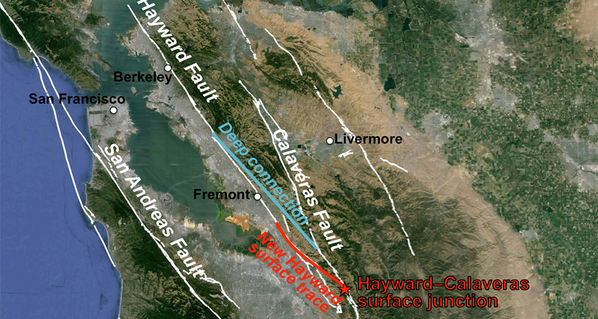
Seismologists from the University of California Berkeley used two decades of satellite data to look at "ground deformation" and "fault creep," a news release explained. Creep describes the constant, slow movement of a fault line as opposed to a fault line that's still between quakes, like San Andreas, according to the U.S. Geological Survey. "The Hayward Fault is actively moving, year-by-year," the USGS noted.
However, as Estelle Chaussard, lead researcher from UC Berkeley, explained to weather.com, though the ground is continuously moving, this movement is not producing any earthquakes. Until, that is, there's a rupture.
Suddenly, a much larger earthquake in California's Bay Area is possible, given the newly discovered link between the two faults. The researchers found that the Hayward Fault creep reached about 10 miles farther south than originally believed, meeting up with the Calaveras Fault. This hidden extension remained that way partially because vegetation covered the ground above it, making it harder to detect than in places where buildings or sidewalks gave away the below-the-surface activity.
Though the newly found creep happens outside of the area's urban centers, an earthquake along these fault lines will certainly be felt in nearby cities. "We thought we could have a magnitude 6.9 earthquake. Now that the two fault are connected, we could have magnitude 7+ earthquakes, 7.3 or even larger depending on where the rupture goes," Chaussard said. "Going from a magnitude 6.9 to a magnitude 7.3, that's 2.5 times the amount of energy released. We have to expect that we could have larger shaking earthquakes than we previously thought."
Next steps for this research include digging into the data, to further refine what Chaussard called "magnitude estimates" for specific spots along the fault line. That will help determine what, if any, adjustments needs to be made to area structures to keep people safe.
"The big question we were trying to address was whether the faults were linked or independent," she said. Now we know there's a direct connection.
The work was accepted into the Geophysical Research Letters journal on Thursday, Apr. 2, 2015.



This "discovery" of a connection between the two fault lines doesn't change the fact that the connecting fault line was there all along. And the fact that there has been constant "creep" of movement in this "new" fault WITHOUT an earthquake, shows that there is much LESS likelihood of a big earthquake here - because of the constant creep, there is no build-up of pressure to be released in an earthquake. Not to say that "the big one" won't happen on another fault somewhere else, but probably not this one.